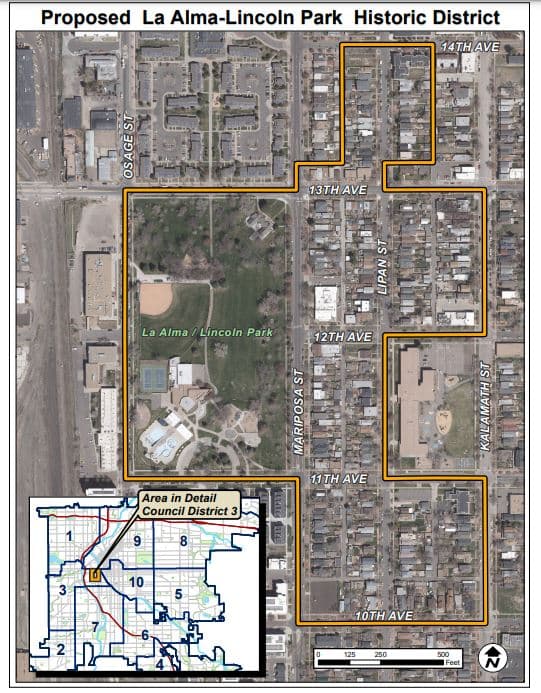This week, the city's planning office said residents had filed an application last month to designate the La Alma Lincoln Park neighborhood as a Historic Cultural District.
Lucha Martinez de Luna, an archaeologist specializing in Mesoamerican cultures and the director of the Chicano/a Murals of Colorado Project, called the project a move toward "healing" for Latinos in the city, whom she believes are often left out of the city's history. She grew up in this area.
"For the community, it's very symbolic in terms of how we've been treated in the past," Martinez de Luna, who has cataloged the removal of Chicano art in the city, said this week.
Establishing a cultural district would mean preserving what is one of the city's oldest neighborhoods, but more specifically in this case, for its connection to the Chicano Movement and for being home to generations of Latino, Mexican-American and Chicano residents.
Principal City Planner Kara Hahn, who works for the city's landmark preservation office, said the application received last month was submitted by three residents, similar to what's required for when people apply to get buildings a landmark designation.
One of the things that makes this application unique is that it's attempting to get historic designation based on new criteria first made available in 2019. The city's laws have three "cultural significance" criteria making structures or districts eligible for historic designation.
Only one structure, Smith's Chapel, has gotten a landmark tag through this criteria; coincidently, this structure is also in the Lincoln Park neighborhood and has connections to the Chicano Movement.
La Alma Lincoln Park has been home to Chicanos and Mexican-Americans for decades.
It became a meeting ground and community space from the 1960s through the 1980s. There are murals there -- including one painted by Martinez de Luna's father, Emanuel Martinez -- that help create a sense of place and connect people to El Movimiento, another name for the Chicano Movement. It focused on addressing unequal treatment in schools, police use of force and labor workers' rights.
For cultural districts, Hahn said city planning will need to establish custom design guidelines for how existing buildings can be renovated to ensure the neighborhood's character stays intact. The Five Points Historic Cultural District, the only existing cultural district in the city, for example, has specific building guidelines. Most historic districts in the city are "high style," Hahn said, which basically means they have a very specific aesthetic.

Creating a design for this neighborhood will mean paying close attention to things like vinyl windows and fences around properties, elements Hahn said are common among houses within the proposed boundary and were added during the period of significance outlined in the application. The guidelines provide some flexibility on materials.
"We have found through the other surveys that we've done around the city that communities with a high proportion of Latino residents, this often something that you see," Hahn said. "So we want to make sure that that's something that's able to continue."
While the application for the district was only submitted last month, the nonprofit Historic Denver has been helping lay the groundwork for this project since 2016, when they provided grant money for historical neighborhood research. Shannon Stage, who manages grants at the nonprofit, said the organization started working with residents in 2017 after providing the money.
The nonprofit hosted meetings and spoke to people who live there and those who grew up there as well.
"That neighborhood is their soul even if they don't live there anymore," Stage said.
Annie Levinsky, executive director at Historic Denver, said close to 150 people provided oral histories, while others have been involved in some capacity since they started working with the community to figure out how to preserve and recognize the area's history. Their research and interviews will people will be used by the city as part of the application.

"It's been really a wonderful process in terms of connecting with people who are really the vessels of this story," Levinsky said.
There are differences between this proposed district and the Five Points Historic Cultural District. Levinsky pointed out the Five Points district covers a primarily commercial strip, while La Alma Lincoln Park encompasses a largely residential area.
City planning is hosting two meetings for people to learn more about what the project will entail. It will host a meeting next Wednesday at 6 p.m. and May 15 at 11 a.m. The city has set up a website for the proposed district.
Hahn said the application could be ready for presentation to the city's planning board this summer before it makes its way to City Council, which has the final say on these decisions. So the district could be formally established by late summer. If the application is successful, the area would join 56 other historic districts in the city.













